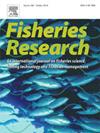Shrinking shrimp - Investigating the weight loss of northern shrimp Pandalus borealis following boiling
IF 2.3
2区 农林科学
Q2 FISHERIES
引用次数: 0
Abstract
Reported landings from commercial fisheries are a main source of information on the removed biomass of a species and/or stock from the sea. In many fisheries, however, on-board processing to meet market demand causes a discrepancy between the landed weight and original live weight, necessitating the use of correction factors during data preparation for stock assessment and advice. One such fishery is for northern shrimp (Pandalus borealis) in the Skagerrak, Kattegat and northern North Sea. In this fishery, large, often female shrimp are boiled in salt water while on-board to maximise sale prices and scientists currently use a correction factor of 1.13 to account for the weight loss of shrimp from boiling. Here, we investigated this correction factor by conducting a weight loss experiment on-board the Swedish shrimp fishery between 2022 and 2024. We estimate that shrimps lose 10.26 % of their weight during boiling which corresponds to a correction factor of 1.11. Further, we find that weight loss likely varies on a seasonal basis, with more weight being lost during Q2 and Q3 compared to Q1 and Q4, potentially due to changes in the biology of the species as well as environmental conditions. Our findings suggest that the current correction factor used in the assessment of the stock should be reduced for the Swedish fishery and should preferably vary based on when the shrimp are caught. The experimental methodology used here could also be used to estimate weight loss in other shrimp fisheries.
缩小虾-研究北方虾在煮沸后的体重下降
商业渔场所报告的渔获量是关于某一物种和/或种群从海上移走的生物量的主要资料来源。然而,在许多渔场,为满足市场需求而进行的船上加工造成了上岸重量和原始活重之间的差异,因此在编制资料进行种群评估和咨询时必须使用校正系数。其中一种渔业是在斯卡格拉克、卡特加特和北海北部捕捞北方虾(Pandalus borealis)。在这种渔业中,通常是雌性的大虾在船上的盐水中煮,以最大限度地提高销售价格,科学家目前使用1.13的修正系数来解释虾的重量损失。在这里,我们通过在2022年至2024年期间在瑞典虾渔业上进行减肥实验来调查这一校正因子。我们估计虾在煮沸过程中损失了10.26 %的重量,对应于1.11的修正系数。此外,我们发现体重下降可能随季节而变化,第二季度和第三季度的体重下降比第一季度和第四季度更多,这可能是由于物种生物学和环境条件的变化。我们的研究结果表明,目前用于评估瑞典渔业种群的修正系数应该降低,最好根据虾的捕获时间进行调整。这里使用的实验方法也可以用来估计其他虾类渔业的体重损失。
本文章由计算机程序翻译,如有差异,请以英文原文为准。
求助全文
约1分钟内获得全文
求助全文
来源期刊

Fisheries Research
农林科学-渔业
CiteScore
4.50
自引率
16.70%
发文量
294
审稿时长
15 weeks
期刊介绍:
This journal provides an international forum for the publication of papers in the areas of fisheries science, fishing technology, fisheries management and relevant socio-economics. The scope covers fisheries in salt, brackish and freshwater systems, and all aspects of associated ecology, environmental aspects of fisheries, and economics. Both theoretical and practical papers are acceptable, including laboratory and field experimental studies relevant to fisheries. Papers on the conservation of exploitable living resources are welcome. Review and Viewpoint articles are also published. As the specified areas inevitably impinge on and interrelate with each other, the approach of the journal is multidisciplinary, and authors are encouraged to emphasise the relevance of their own work to that of other disciplines. The journal is intended for fisheries scientists, biological oceanographers, gear technologists, economists, managers, administrators, policy makers and legislators.
 求助内容:
求助内容: 应助结果提醒方式:
应助结果提醒方式:


